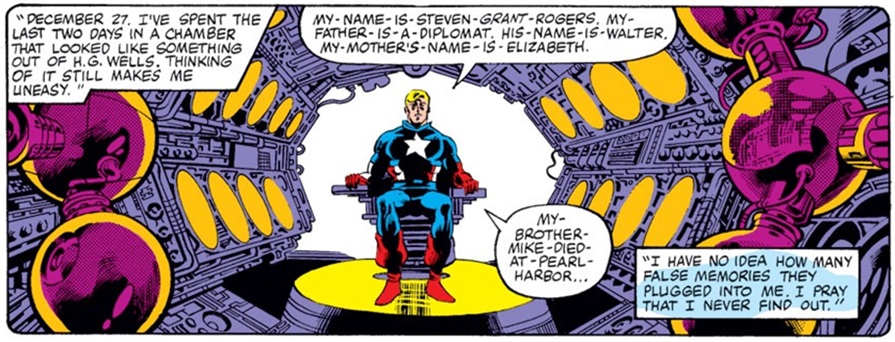
FALSE MEMORY CHAMBER
Classification: Terrestrial technology (1940s era)
Creator: Unrevealed
User/Possessors: U.S. military; Captain America (Steve Rogers)
First Appearance: Captain America I#247 (July, 1980)
Powers/Abilities/Functions: A
large tunnel-like enclosure constructed from numerous unspecified
electrical devices, this apparatus provided a non-surgical method of
implanting false memories into the sub-conscious minds of individuals
subjected to it, possibly by using
some advanced form of hypnosis and/or subliminal conditioning.
The memories were so vivid that the individual would believe them to be
true.
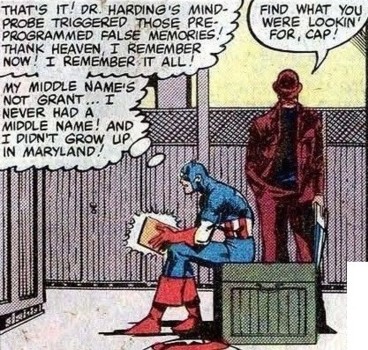
History:
(Captain America I#247 (fb) - BTS) - The U.S.
military developed the "False Memory Chamber" under unrevealed
circumstances (see comments).
(Captain America I#247 (fb)) - On December 24th, 1941,
Pvt. Steve Rogers reported to General Phillips' office. He learned that
he would be given a false set of memories to confuse the enemy in the
event he was captured and tortured. Steve was introduced to Walter
Rogers (presumably no relation)
of the State Department, whose sons--Mike and Grant--died at Pearl
Harbor. Phillips told Steve that the elder Rogers' family would serve as
the basis for the fictitious past that would be implanted in Steve's
mind (see comments).
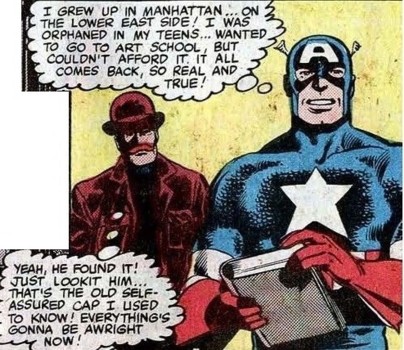
Steve Rogers was seated in the chamber (which
he thought looked like something from the writings of H.G.
Wells); he spent three days undergoing the procedure (see
comments), and the false memories were successfully implanted into his
mind. Although Steve didn't know how many false memories were programmed
into him (and he prayed he never found
out), some of them included the personal "facts" that his
middle name was Grant (he actually
didn't have a middle name), his father Walter was a diplomat,
his mother was named Elizabeth, and his brother Mike died at Pearl
Harbor.
At some point afterward, Steve wrote an account of his
experience in the "false memory chamber" in his war journal.
(Captain America I#247) - In modern times, a troubled
Captain America felt the memories of his youth were muddled following an
earlier mind-probe (see comments), so he went to SHIELD headquarters for
help. Dum Dum Dugan took Cap to a Fort Dix, New Jersey storage depot,
where Cap recovered his journal from his wartime footlocker. Cap read
about his experience in the "false memory chamber," which unleashed a
flood of memories about his true past that restored his self-assurance.
Comments: Created by Roger Stern and John Byrne.
In regards to "false memory chamber": This gizmo was never
officially named in this story, but it was referred to as such in the
Official Index to the Marvel Universe.
Steve Rogers wrote in his journal that he had spent three
days in the "false memory chamber," but he didn't appear to have any
intravenous-feeding lines in his arms, so I'm assuming he didn't spend
all those days continuously undergoing the process--he may have been
given some time off for eating, sleeping, stretching his legs, and
"personal breaks".
Maybe the "false memory chamber" was the American
military's version of the Nazis' "nullatron". The "nullatron" was once
used by the Red Skull to place Captain America and his fellow Invaders
under hypnotic control (@ Invaders I#6); later, the plans for the
nullatron were adapted by the Ringmaster
(Maynard Tiboldt) for his "hypnotic hat" (@ Incredible Hulk I#3).
Captain America I#215 (November, 1977) began the sub-plot
of Steve Rogers on a quest to discover his forgotten pre-war past. This
sub-plot culminated in Captain America I#225 (September, 1978), wherein
Cap was subjected to a mind-probe device by Dr. Mason Harding (creator
of the Madbomb)
to unlock the memories of his early family life. In a flashback
sequence, it was revealed to Cap (and the readers) that Steve Rogers
came from a wealthy upbringing in Maryland, with his parents Elizabeth
and Walter (a diplomat with the State Department) and his brother
Mike--Steve, the weaker and more sensitive of the two sons, was a
disappointment to his father. Steve later attended art school in New
York, and learned of his brother's death at Pearl Harbor, then tried to
enlist in the armed forces. But the story in
Captain America I#247 discounted that flashback and relegated it as
fictitious. We now know that during the Great Depression, Steve Rogers
(an only-child) was born into an impoverished life on Manhattan's lower
east side. Steve's father Joseph Rogers (an often-unemployed chronic
drinker) died when Steve was still a child; in his late teens, Steve's
mother Sarah died of pneumonia, leaving him an orphan.
Although the "false memory chamber" did serve the purpose
of conveniently wiping out the earlier flashback, I couldn't follow the
reasoning for the whole implanted memories plot--Steve Rogers had no
apparent living relatives who might have been threatened by enemy
retaliation, so what purpose did it serve to tie Captain America to
Walter Rogers and his family, and thus potentially jeopardize
their lives?
Timely Comics was still publishing the adventures of
Captain America and Bucky into the late-1940s, with the characters
referred to as "Steve" and "Bucky" in their civilian identities. But
modern Marvel continuity has established that Cap (Steve Rogers) and
Bucky (Jim Barnes) were lost and presumed killed-in-action in April,
1945, and their costumed identities were assumed by replacements (@ What
If? I#4). Cap was replaced first by William
Nasland (formerly the Spirit of '76), and later (following the
death of Nasland at the hands of Adam-II's
android) by Jeff
Mace (formerly the Patriot), while Fred Davis filled in as Bucky.
Since this retcon occurred after the publication of the late-1940s
stories, maybe they could explain the later "Steve" and "Bucky"
references by revealing that Nasland, Mace, and Davis also underwent the
same false memory procedure to temporarily cover their true
identities--maybe they had living relatives they wanted to protect from
enemy reprisal, so making them think they were "Steve Rogers" and "Bucky
Barnes" (two "dead" men with no known living family members) would seem
to be the perfect "hiding place" should the secret of their alter-egos
ever be compromised (Of course, this
is not an issue for William
Burnside, the Atlas Comics Captain America of the 1950s, since
he was using the "Steve Rogers" identity anyway.)
And maybe there's one other continuity glitch for which the "false
memory chamber" could be used. References were made in the past to both
Reed Richards and Ben Grimm serving in the military during World War II
(as early as Fantastic Four I#11), and they both had memories of
encountering Sgt. Fury and his Howling Commandos (e.g. Reed in Sgt.
Fury#3 (and mentioned in Fantastic Four I#21), Ben in Marvel
Two-In-One#77). While these flashback memories
were feasible in the stories published in the 1960s, and even into the
1970s, they were later ignored, because in order to have fought in the
war, Reed and Ben would have been senior citizens by the 1980s. So the "sliding time-line" came into effect, and the Fantastic
Four have only been around for 10-15 years (Marvel-time), even though
their comic-book has been published since 1961 (real-time), thus Reed
Richards and Ben Grimm are now considered too young to be WWII veterans
(Of course the aging issue is not a problem for Nick Fury,
who stays relatively young because of
Dr. Berthold Sternberg's Infinity Formula).
But that still leaves the quandary of explaining those
previous mentions by Reed and Ben about serving in World War II and
fighting alongside Sgt. Fury, so here's an idea for a solution: Maybe
there's an untold pre-Fantastic Four tale wherein Reed and Ben assisted
CIA agent Col. Nick Fury on a case involving the "false memory chamber".
At some point, they were all simultaneously exposed to that device,
which created a mental-link among the three, with Fury's memories as the
matrix, and this experience left the trio with shared delusional
memories that they had met in the 1940s (Sure,
it's convoluted, but it's a lot simpler than explaining it through
time-travel).
And THANK YOU! to Norvo for originally providing me with
the images!
Profile by Ron Fredricks.
CLARIFICATIONS:
The "false memory chamber" has no known connections to:
- Behavior
Modification Machine of Earth-712 - mind-altering device
created by Tom Thumb--Squadron Supreme I#4
- Hypno-Presuader
- mind-altering device used by Doctor Doom--Fantastic Four I#85
- Id
Machine - mind-altering device created by the
Wizard--Fantastic Four I#41
- Remembrancer
- device used to brainwash Kristoff Vernard into thinking he was Dr.
Doom--Fantastic Four I#278
- any other similarly named devices or mind-altering
machines
Walter Rogers has no known connections to:
- any other similarly named characters
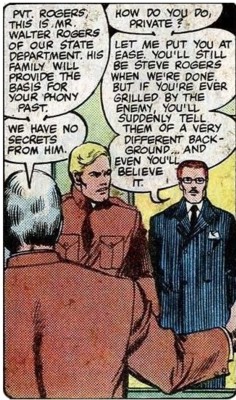
|
Walter Rogers
A diplomat with the U.S. State Department in the 1940s, he
and his wife Elizabeth had two sons, Mike and Grant. After their sons
were killed in the attack on Pearl Harbor in 1941, Rogers volunteered to
have his family's life used for the basis of false memories that would
be implanted into the mind of Captain America (Pvt. Steve Rogers (presumably no relation)). Walter
assured Steve that he would still be himself after the procedure was
over, but in the event that he were ever interrogated by the enemy, he
would give them an entirely different background story (based
on Walter Rogers' family life) that even Steve would believe
was true. Although Steve warned him of the grave danger in which he
could be placing his family, Walter Rogers let him know that after
losing their two sons, it was the least he and his wife could do.
The fate of Walter Rogers in modern times is unrevealed.
--Captain America I#247
|
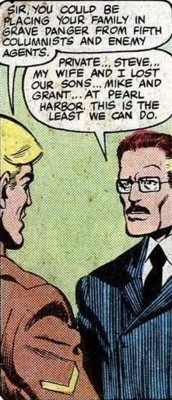
|
images: (without ads)
Captain America I#247 p10 pan6 (main image - Captain America sitting in "false memory chamber" in 1941)
Captain America I#247 p11 pan1 (Captain America learning about "false memory chamber" after reading his war journal, as Dum Dum Dugan stands by him; present times)
Captain America I#247 p11 pan2 (Captain America feeling self-assured after learning his past memories were false, Dum Dum Dugan in background; present times)
Captain America I#247 p10 pan4 (Gen. Phillips and Pvt. Steve Rogers meet Walter Rogers in 1941)
Captain America I#247 p10 pan5 (Pvt. Steve Rogers warns Walter Rogers of the risks in 1941)
Appearances:
Captain America I#247 (July, 1980) - Roger Stern (writer), John
Byrne (co-plot, penciler), Josef Rubinstein (inker)
First Posted: 05/22/2016
Last updated: 09/29/2025
Any Additions/Corrections? please let me know.
Non-Marvel
Copyright info
All other characters mentioned or pictured are ™ and © 1941-2099
Marvel Characters, Inc. All Rights Reserved. If you like this stuff, you
should check out the real thing!
Please visit The Marvel Official Site at: http://www.marvel.com
Special Thanks to www.g-mart.com
for hosting the Appendix, Master List, etc.!
Back
to Items




